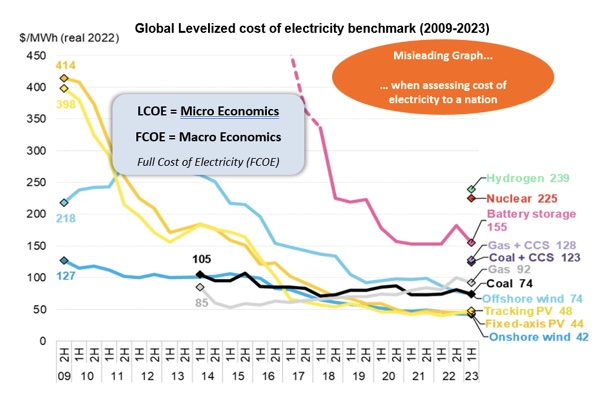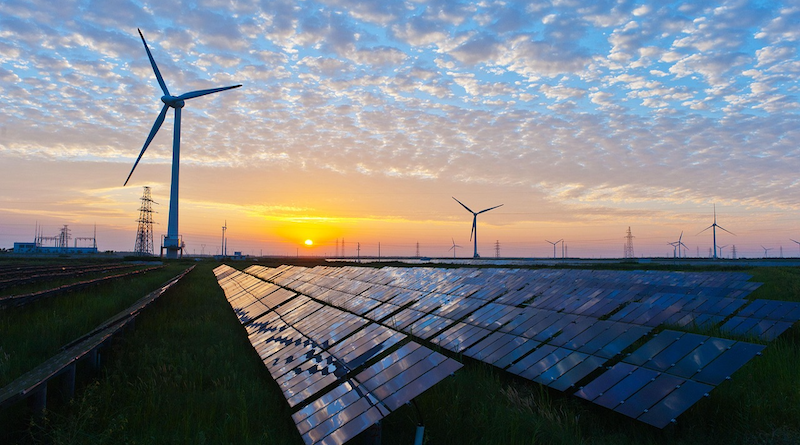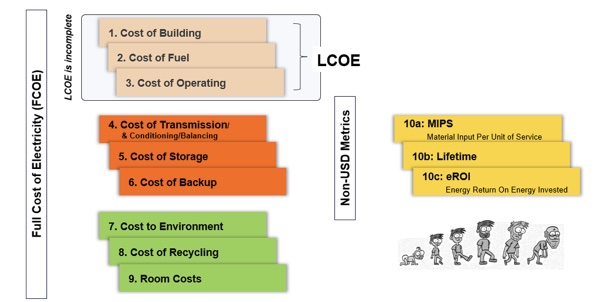The ‘Energy Trilemma’ And The Cost Of Electricity – OpEd
Why “Renewables” cannot save but cost Billions
Over the last 150 years, abundant electricity from coal and gas led to an unprecedented reduction in poverty, as well as an increase in longevity and health. Currently, these low cost, reliable power sources generate approximately 60% of electricity and 50% of primary energy worldwide. Primarily due to climate change concerns, coal and gas fuels are now slowly replaced by ‘renewables’, such as wind and solar based energy. But this comes with a cost.
Bloomberg issued their latest global Levelized Cost of Electricity (1) (LCOE) analysis in 2023, comparing the historical LCOE of various ‘renewables’ with the cost of coal, gas, and nuclear, drawing a misleading conclusion of wind and solar being most cost-effective (Figure 1). LCOE based reports and analyses also by other organizations such as IEA, IRENA, IEEFA, IMF, Agora, form the basis for many governments to mistakenly conclude that the transition from a coal and gas based power system to wind and solar will save billions, if not trillions at global scale.
Political decision makers know the three pillars of a successful energy policy (a) reliability, (b) affordability, and (c) environmental sustainability. But when taking a closer look, it becomes apparent that, power ministries are struggling to find a balance within this ‘Energy Trilemma’ and moreover, that the three pillars follow a specific priority:
As a prime concern, access to reliable energy is needed, before considering the affordability thereof. Once the balance between reliable and affordable energy is achieved, only then environmental sustainability can be tackled in a meaningful way.
Claiming “renewable” energy from wind and solar is cheap and comes without environmental consequences, is a crucial and detrimental energy economic misunderstanding.
The unpopular truth, which is undisputed even by top energy economic institutions such as OECD and IEA, is that (a) wind and solar at grid scale are always more expensive than coal and gas, even nuclear, and (b) the total costs to an economy rises exponentially with higher wind and solar share in the power system. The result is that the proposed “energy transition” would cost over 7 – 10% of the global GDP, amounting to trillions of dollars, and as per IPCC data would supersedes the cost of a warming climate.

Figure 1: Bloomberg LCOE analysis (source Bloomberg New Energy Finance BNEF)
Why is it wrong to use LCOE when evaluating the cost of power to a country?
LCOE, levelized cost of electricity, is s a “micro economic” instead of total system view, excluding seven cost categories (listed below), and therefore, will never be an accurate indicator for governments to base energy policy decision on.
LCOE is misleading because it does not consider nor account for intermittency, low natural capacity factors, correlating wind and solar ‘availability’ across continents, and the locational disparity of demand and supply.
Obvious costs omitted from LCOE:
- Backup or long duration energy storage (LDES): Wind and solar require at least 100% backup or storage for every installed MW. (2)
- Network integration, including costs for transmission, distribution, balancing, and conditioning.
Not so obvious costs omitted from LCOE at grid scale include:
- Efficiency losses – more wind and solar means less asset utilization (3) of backup or grid systems.
- ‘Room’ costs Space requirements? driven by low energy density (per m²) of wind and solar. There is an economic and environmental cost to “utilizing” thousands of km² to capture the diffuse energy from the sun and wind.
- Recycling costs, driven by low energy density (per kg) and short lifetime of wind and solar.
- Environmental costs – i.e. damage to plant and animal life, negative effects on climate systems, including from warming, wind extraction, and atmospheric changes.
- Raw material and net energy inefficiency (eROI) – of production, processing, transportation, upgrading, manufacturing, and recycling of the entire system, including its environmental impacts.
Only an estimate of the Full Cost of Electricity FCOE will include all costs and should be used (Figure 2) to evaluate the total cost to a country or system.
What is the impact on humanity, when grid scale wind and solar technologies increase energy costs and reduce energy reliability? The Economist estimated that, in the UK during the winter of 2022/23 alone, high energy prices resulted in over 65.000 excess deaths, more than those caused by Covid19. High energy costs cause increased suffering for the poor and slow industrial development not only in developing nations.
Not every solar panel or windmill is undesirable, there are applications and locations where they make sense. However, logically, if wind and solar are a substandard grid-scale power solution, so is hydrogen, produced from wind and solar. Remember, H2 for storage “loses” 65-80% of input energy for production, storage, transportation, and repowering. Hydrogen is hazardous to store and transport, highly explosive and so “thin” that it penetrates and embrittles steel. When leaked it’s “warming impact” would be 12 times that of CO2.
In conclusion, we can agree that we must endeavour to reduce the environmental externalities of all our energy systems. However, the ‘transition’ to wind, solar and hydrogen leads to an increase in the cost of energy and reduction in reliability, as well as serious impacts on ecosystems which is counterproductive and results in undesired consequences for humanity.
Poverty, peace, health, education, and the environment should have our highest attention and are short of funds. We should divert investment from wind, solar and hydrogen and/or batteries to where the money will make a genuine positive impact to our environment and economies. For a truly long-term sustainable,
energy dense future, in addition to more R&D and fission/fusion, we should invest in building/upgrading to newest high efficiency thermal power plants and installing up-to-date filter systems, globally.
We urgently need investments in power plants, fuels, and refineries to avoid a prolonged global energy crisis with all its consequences to lives, health, and wealth, especially for the impoverished.
The first precursors to this energy crisis appeared in 2021 prior to the Ukraine war.
For a more in-depth explanation on these issues touched upon in this article, please refer to our recent book. “The Unpopular Truth… about Electricity and the Future of Energy”, at Amazon and www.unpopular-truth.com.
A selected list of references supporting that LCOE cannot be used to compare wind and solar with dispatchable thermal power generation at grid scale can be found here https://unpopular-truth.com/lcoe-links-htm/ .
Notes:
- LCOE measures only the cost of building, operating, and providing fuel (usually inc CO2 taxation) for generating electricity. It does not include other costs, such as but not limited to network integration, backup/storage, recycling, etc. See Figure 2
- I say at least because of energy losses of backup/storage systems, and short and long-duration energy storage maybe two systems.
- Asset utilization can be explained with a car. Compare the total cost of a car such as purchase, maintenance, insurance, and fuel per km when you (a) drive it once every week for 5 min vs. (b) when you drive it every day for 2 hours straight without interruption.


